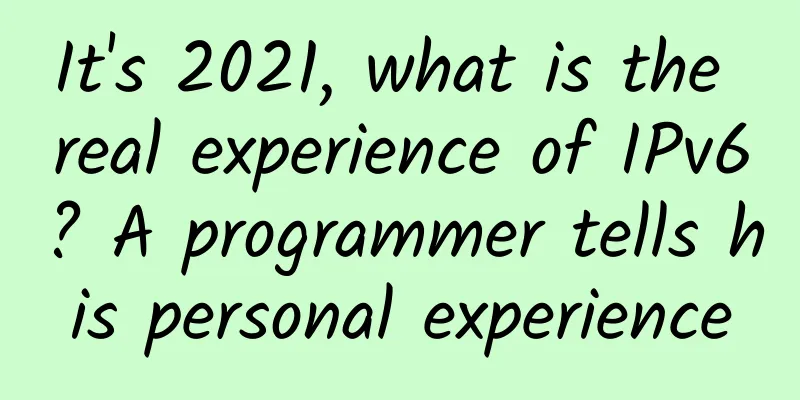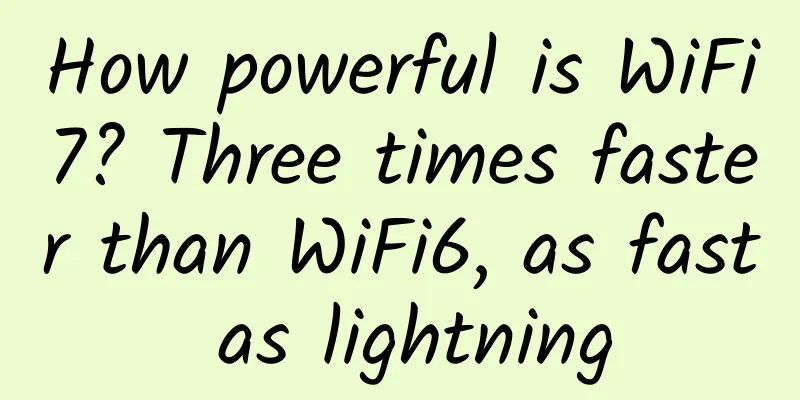It's 2021, what is the real experience of IPv6? A programmer tells his personal experience

|
Since the issuance of the "Action Plan for Promoting Large-Scale Deployment of Internet Protocol Version 6 (IPv6)" in 2018, the large-scale deployment of IPv6 in my country has been rapidly promoted. As of October 2021, the number of IP6 addresses owned by mainland China reached 59,032 blocks/32, ranking first in the world. The support rate for website applications of IPv6 has also been greatly improved. Data source: National IPv6 Development and Testing Platform It can be said that IPv6 has been around us for a long time, but what is the real experience of IPv6? Is it almost the same as IPv4? A software development engineer shared his experience of using IPv6. Due to the company's business relationship, the users this software development engineer faces happen to be the first batch of people in China to experience home IPv6 broadband. Most of these users know how to operate a computer. Half of them are computer network players who are proficient in operation. About one-third of them are software developers, and about one-third of them use the Linux operating system. Based on his own experience and the problems users encounter when using IPv6, the software development engineer summarized some of the current problems encountered when using IPv6, as well as his own and his users' experience. IPv6 full coverageFirst, he talked about the coverage of IPv6. Nowadays, most fiber-optic broadband in the core urban areas of municipalities, provincial capitals, and large and medium-sized cities have opened IPv6 networks, and there are almost no cases where 4G and 5G networks cannot support IPv6. However, IPv6 has not been supported in economically underdeveloped areas or marginal cities. The main reason is that operators do not have enough funds and can only support IPv6 networks in backbones and hubs. Customer SupportThe customer service staff of China Mobile, China Telecom and China Unicom have not received any training on the IPv6 system. In many cases, the software development engineer asked users to call the operator to activate IPv6. However, the customer service staff of the three major operators have a serious lack of knowledge about IPv6. Not only do they not know how to activate IPv6, they don’t even know what IPv6 is.
Many times, when users call to activate IPv6, they are told that IPv6 is not available. It is not until they call back in a more firm tone that they are told that IPv6 is supported. He said that other regions of the three major operators have seriously insufficient training on IPv6. Only the customer service training of China Telecom, China Unicom and China Mobile in Shanghai is relatively complete and can basically be activated in one go. Optical modem problemSome very old 100M customized optical modems are difficult to support IPv6. The operator cannot enable IPv6 by sending data remotely, and can only ask staff to visit the site and use administrator privileges to enter the management page to manually turn on the IPv6 switch. However, even so, many problems will still be encountered during use. The best solution is to replace the Gigabit optical modem or router dial-up, but it is very troublesome. Replacing these old devices also requires a certain amount of time and financial support, which is relatively difficult. Fake IPv6 ProblemThe development engineer also said that in the process of communicating with users, he also found the problem of fake IPv6. This problem is mainly concentrated in small cities with underdeveloped economy and weak strength. In order to complete the IPv6 tasks assigned by superiors, operators do not use IPv6 PD prefix allocation, but instead allocate one IPv6 address to each broadband like IPv4. Firewall settings are messyOperators in some areas directly copied the IPv4 settings, resulting in IPv6 being able to only go out but not in, turning it into an intranet... operating systemThe Linux system has good compatibility with IPv6, but Android has some problems. This problem may be caused by the Android system's point-saving strategy. The specific problem is that if an Android device always maintains a connection to the same WiFi intranet, when the intranet gateway redials, the IPv6 address will change. At this time, the IPv6 address will not be updated immediately and the old address will still be used. When the user goes online, IPv4 is actually used instead of IPv6. The engineer listed the IPv6 problems he found in his work. He also said that although there are still many problems with IPv6, with the vigorous promotion of IPv6, the problems caused by IPv6 are also decreasing year by year. If the problem incidence rate in 2019 is 60%, then the problem incidence rate in 2020 may be around 25%, and by 2021 it will be less than 10%, which is a very obvious improvement. Although the user experience of IPv6 is still not as good as that of IPv4, we can see that IPv6 is constantly being improved, and the day when it will completely replace IPv4 and become the mainstream is coming soon. |
Recommend
9 misunderstood truths about 5G that many people have gotten wrong
1. Does 5G base station have high radiation? 5G, ...
5G scenarios and technologies bring new security threats
The virtualization characteristics of 5G networks...
The United States' 5G millimeter wave technology is marginalized, and global operators are promoting 5G centimeter wave technology
[[344927]] There are two technical standards for ...
[11.11]80VPS: 50% off all VPS, special VPS annual payment starting from 199 yuan, multiple data centers in Hong Kong/US/Japan/Korea, etc.
80VPS also launched a promotion during the Double...
How to better migrate data centers
Migrating a data center is no small feat, and it ...
my country will start deploying and building IPv6 address projects in 2017
[[181003]] A reporter from the Economic Informati...
5G and Edge AI: Solving Traffic Management Problems
The way we commute may have changed over time, bu...
Kubernetes Gateway API v1.1 Interpretation, do you understand it?
A few days ago, the K8s Network SIG released the ...
100 basic network knowledge popularization, read it to complete half of the network master
This article is about popularizing 100 basic netw...
IKIHOST: $4/month-4GB/40G NVMe/1Gbps unlimited traffic/Los Angeles data center
The tribe shared information about IKIHOST last y...
RAKsmart: US servers starting from $30, Hong Kong servers/cluster servers pre-sale, US cluster servers/1-10Gbps bandwidth servers/high-defense servers special offers
There is only one month left in 2020, and RAKsmar...
The 5G infrastructure market will reach $496.6 billion in 2027, with a CAGR of 106.4%.
According to a new study released by market resea...
Ruijie Networks releases simplified Ethernet all-optical 3.X solution, Ethernet color optical leads the innovation of campus all-optical network
On the afternoon of April 25, Ruijie Networks hel...
What is the difference between private and public LoRaWAN networks?
[[331465]] The low-power wide-area network (LPWAN...
Is the epidemic a booster or stumbling block for 5G?
A sudden epidemic seems to have disrupted the dev...









